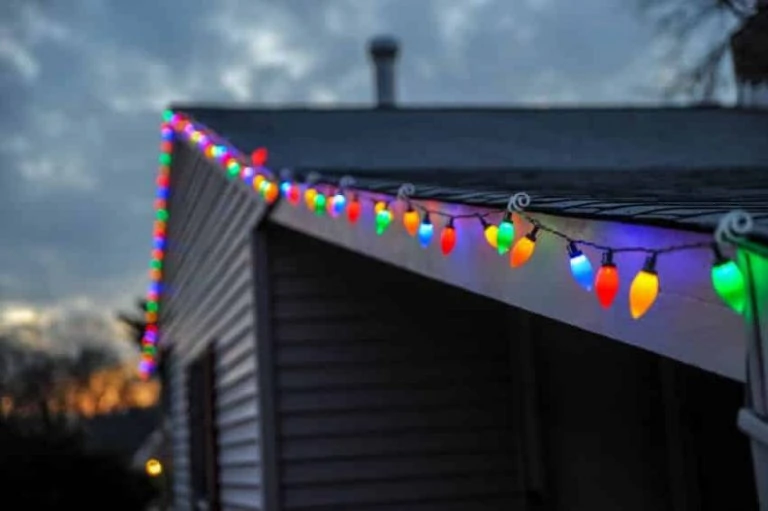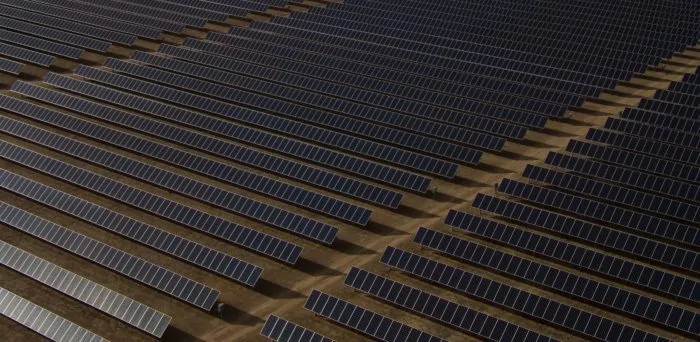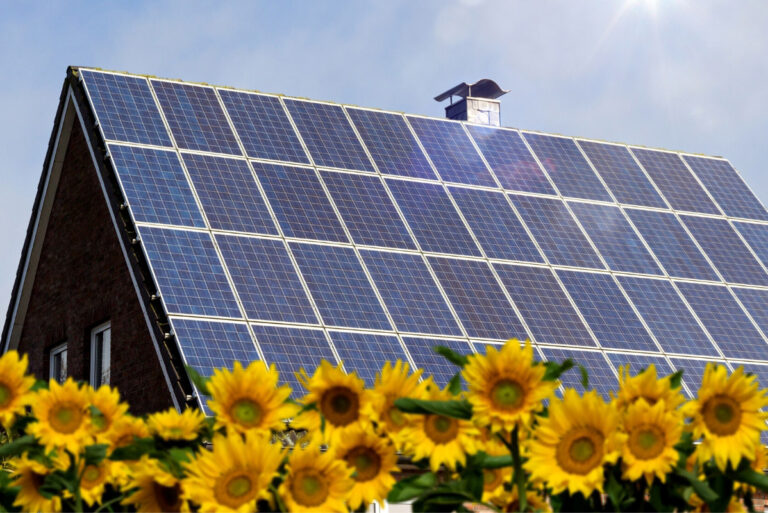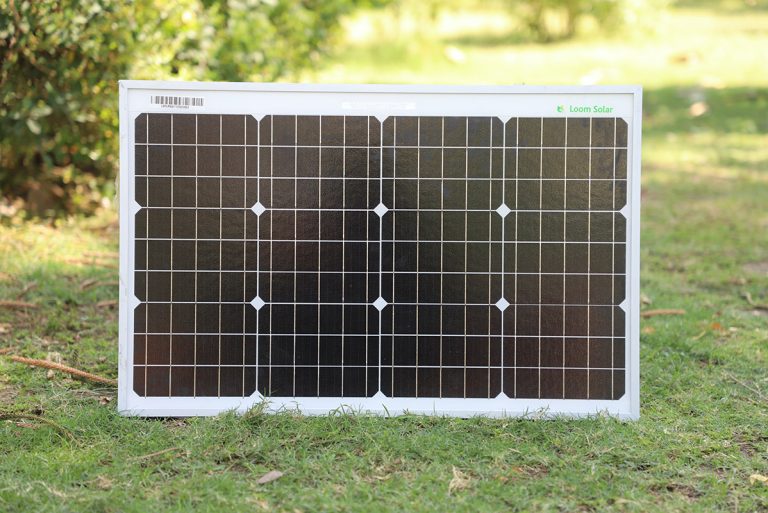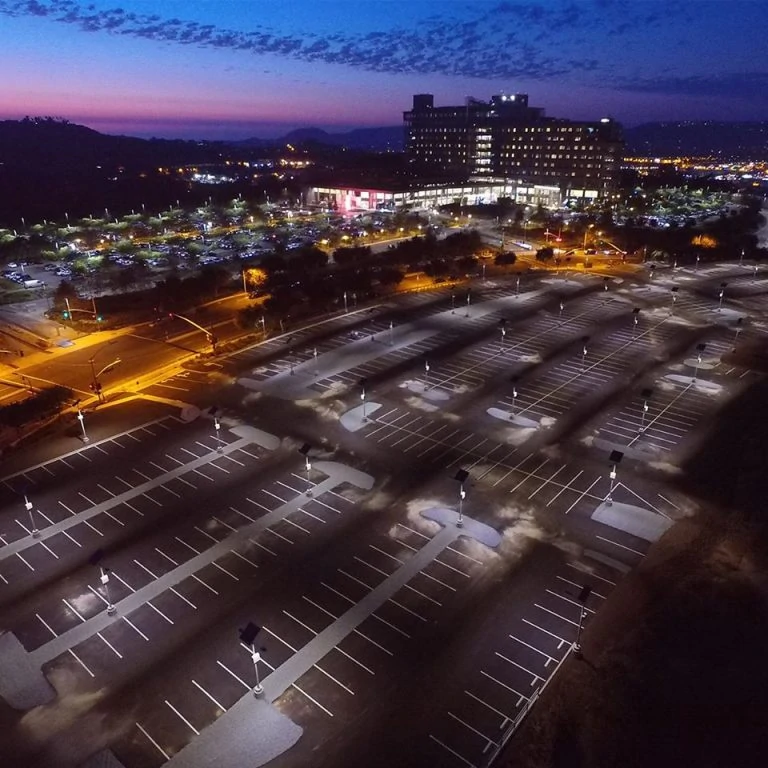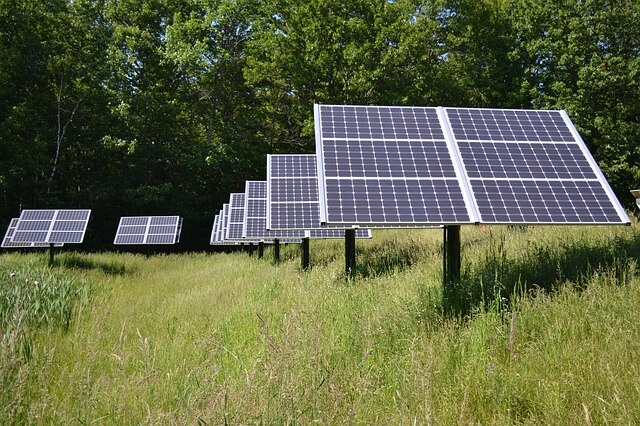If you’re like many farmers, ranchers, and landowners, you’re experiencing our climate crisis firsthand in undesirable ways. Drought, extreme heat, and flooding are wreaking havoc on your very means of survival: your land.
The situation is so hopeless for some that drastic measures such as selling their property seems to be one of the only solutions remaining on the table.
Fortunately, there is an alternative.
Have you considered leasing your land as a solar farm?
In this article, you’ll find out everything you need to know about solar farms as a way to create a steady income from your land for 25-50 years.
Let that sink in for a minute.
Meeting the solar farm land requirements could set you up for early retirement today! Or maybe not. It all depends on a number of factors.
Here you’ll discover:
- Advantages and disadvantages of leasing your land for solar energy production
- Solar farm land requirement details, rules, and regulations
- Best of all: Your compensation!
It’s all here in one blog post.
Our in-depth analysis on all the essentials about solar farm land requirements concludes with a list of the top 7 tips for farmers, ranchers, and landowners thinking about leasing their property to a solar developer or solar storage business.
What is a solar farm?
You’re used to seeing “amber waves of grain” billowing in the breeze across acres and acres of farmland as far as the eye can see.
Now just imagine rows upon rows of hundreds or hundreds of thousands of ground-mounted solar panels, often with adjoining buildings that house immense batteries to store the power generated by those photovoltaic (PV) modules for later use.

Also called solar parks, plants, fields, or power stations, solar farms are becoming commonplace throughout the world. As countries, states, and municipalities transition toward phasing out fossil fuels as energy sources, they are actively looking to expand clean energy capacity — namely, solar and wind energy — in their jurisdictions.
This is where you, as a farmer, rancher, or general landowner, come into the picture. Solar developers want you to partner with them in solar projects that generate electricity.
Types of solar farm
There are two main types of solar projects that solar developers are actively pursuing right now all over the United States:
1. Utility solar farms
In the case of solar farms consisting of thousands or hundreds of thousands of PV modules on your property, the developers will sell the electricity created by the solar panels to a public utility in urban and suburban areas. In rural settings, the power will go to an electric cooperative.
In these cases, the electricity generated by sun energy hitting the PV panels travels on the electric grid for widespread use by consumers or corporate entities located far from your farm.
Alternatively, the developers will sell the electricity to large corporations, institutions, or university systems that have massive demands for power in centralized settings. They also want to purchase renewable energy instead of electricity generated from fossil fuels.
2. Community solar farms
Solar developers could also sell the electricity created on your land to locally organized groups of individuals who become subscribers to a community solar program. These people may not have the means or space to purchase their own rooftop solar system, but still wish to participate in the renewable energy revolution.
Community solar members purchase shares of the energy created on your solar farm. Others interested in solar energy may enter into power purchase agreements (PPAs) with public utilities at a fixed cost for a certain length of time.
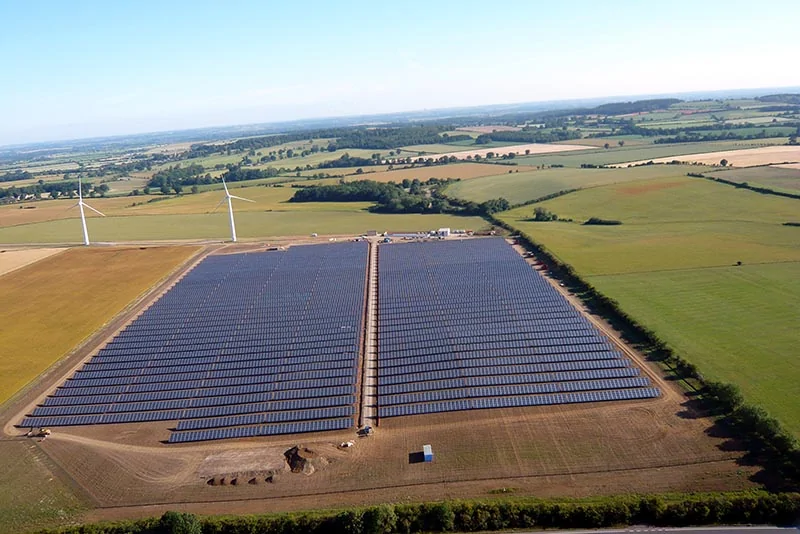
Source: Wikimedia / MrRenewables
Typically, utility solar power stations are huge in comparison to community solar farms. This means that your property — whether big or small — could be a candidate for leasing a solar farm.
How much land do you need for a solar farm?
Solar farms can take up a few acres of land or tens of thousands. There are many reasons for the wide differences that we’ll explain in this section.
The size of a solar farm defines how much electricity it creates. The bigger the solar farm, the greater the power output.
In fact, instead of using a land measurement to describe the size of a solar farm, they are classified according to how much electricity they can generate from the sun. This quantity is called their capacity to generate electricity. Capacity is measured in watts, the standard unit for electrical power.
Sample calculation for determining the size of a solar farm
To illustrate how the size in acreage corresponds to the size in wattage to a solar farm, here is a sample calculation. Using it, you’ll be able to predict the largest solar farm size that your property could reasonably service.
To start, think of something more familiar: a rooftop solar array.
For an average American family using 900 kilowatt hours (kWh) per month, (or 30 kWh/day), the solar system would be sized at about 7.5kW. This estimation assumes full sun directly hitting all the panels for 4 hrs./day. (We determine the size by dividing 30 kWh by 4 hrs.) Such a system is large enough to cover approximately all of household energy demands.
Note: In reality and to guarantee that their home energy needs are met, homeowners may opt to increase their calculated system size by 15-20% to account for:
- Occasional lack of full sun
- Panel inefficiency
- Energy losses in transmission and DC to AC conversion
- Module degradation over time.
To figure out how much roof space you need for the PV panels producing 7.5kW, assume each kilowatt requires 100 sq. ft. This is the standard area used in calculations of this sort.
So, you’ll need 100 x 7.5 = 750 sq. ft. of roof space to house a 7.5kW residential solar system.
When it comes to solar farms, everything is calculated in a similar fashion but on a much grander scale.
For instance, a 5 MW (megawatt, where 1 MW = 1,000 kW) solar farm would require a minimum of 100 x 5,000 = 500,000 sq. ft.
Given the equivalence of 1 acre = 43, 560 sq. ft., that works out to be about 11 ½ acres needed for a 5 MW solar park.
Note that’s just for the panels. Figure in an additional 8-10 acres more to house other solar system hardware plus the space needed between rows to avoid shading (and consequent power loss) as well as space for periodic array maintenance.

Source: Wikimeadia / JUWI Group
That brings the total for a 5 MW solar farm to 11.5 + 10 acres = 21.5 acres. This is a conservative estimate.
Other sources suggest 6-8 acres for each megawatt of power produced is needed to build a profitable solar farm.
Note that as PV module technological improvements result in higher panel efficiencies, fewer acres per megawatt will be needed.
To give you a better idea of the type of solar power station that could operate on your land, consider a community solar farm. These days, it’s typically 1-10 MW in size. A utility project may be sized at 25 MW up to 1 GW (1 gigawatt = 1,000 megawatts).
Here’s a table of information that gives you a better idea of how much land is required for solar farms of various capacities. The data are derived from a National Renewable Energy Laboratory (NREL) report.
Notes about the table: The “ac” written after the wattage unit stands for alternating current. This refers to the electricity that has already been transformed from the direct current (DC) electricity produced by the PV array. AC current is necessary for integration with electric grid power lines.
Fixed panels do not move along with the sun. Single- and dual-axis trackers move the PV modules up and down and from left to right during the day in order to capture the maximum amount of sunlight all the time. CPV is an advanced solar technology.
Table 1. Solar farm land requirements in the United States, as measured by megawatts (MWac) of electrical power generated
| Technology | Average direct land use (acres/MWac) | Average total land use (acres/MWac) |
|---|---|---|
| Small PV (>1MW, <20MW) | 5.9 | 8.3 |
| Fixed | 5.5 | 7.6 |
| Single-Axis | 6.3 | 8.7 |
| Dual-axis, flat panel | 9.4 | 13 |
| Dual-axis, CPV | 6.9 | 9.1 |
| Large PV (>20MW) | 7.2 | 7.9 |
| Fixed | 5.8 | 7.5 |
| Single-Axis | 9.0 | 8.3 |
| Dual-Axis CPV | 6.1 | 8.1 |
How much does it cost to set up a solar farm?
According to the latest national average cost figures from the Solar Energy Industries Association (SEIA) taken from their second quarter (Q2) report of 2021, the turnkey installation cost of non-residential and fixed tilt utility PV ranges between $0.77 to $1.36 per watt.
By comparison, a residential rooftop or ground-mounted solar system costs between $2.50 and $3.50 per watt. When buying in large quantities for solar farm projects, solar developers save on equipment costs.
Generally, solar developers pay a total installation cost of $3 million per megawatt to build a solar farm (excluding the cost of land). This amounts to about $500,000 per acre.
For a quick return on investment, solar developers are usually unwilling to build a solar farm under 1 MW in capacity. However, for land that is optimally suited to yield a quick return on investment, they may consider it. See below for more on what makes your land ideally suited for a solar farm.
Solar farm lease rates
Granted your property adheres to all necessary solar farm land requirements, the typical solar farm lease rate varies between $600 – $1,200 per acre for every year of your contract.
If you’re able to hire a savvy lawyer who will tirelessly advocate for you during contract negotiations with a solar developer, you could make sure annual rent increases are included as well as adjustments for inflation.
If your lawyer’s negotiating skills are outstanding — or the solar developer is desperate for your land — adding in partial royalty payments would increase your income even more.
Factors that affect solar farm lease rates
How much money you get for leasing your land for a solar farm depends on several factors. Here are the most important.
1. Interconnection proximity
If your property is located near transmission or distribution lines or a substation, that makes it super easy — and cheap — to send the power a solar farm on your property generates to the electric grid.
Two caveats:
- The line or substation voltage is close to the voltage that your farm’s capacity delivers;
- The line has available injection capacity to absorb what your solar farm sends to it.
2. Suitability of your land for a solar farm
Solar developers scout out flat, clear land as ideally suited for a solar farm. This means less than 5° of slope, but more may be acceptable if it’s facing south.
There shouldn’t be trees or buildings that can obstruct sunlight or cause shading issues. Nor should there be waterways.
Having a major road or two adjacent to or running through your property will make it easier for construction vehicles to access your land.

A large plot of land (hundreds of acres) is often more valuable on a per acre basis than a smaller one if a solar developer is looking to build a huge solar power station.
However, if they wish to build numerous small solar parks in a particular region due to local tax incentives that encourage the creation of community solar projects, a small land parcel will be perfect.
3. Market supply and demand for solar farms
Of all the major factors that influence solar farm lease rates, this one is most likely to evolve over time. Changes may happen on short notice, propelling solar developers to hunt out suitable land for solar farms and get signed contracts quickly.
If your state or county recently announced its goal for increasing renewable energy in a Renewable Portfolio Standard (RPS) within a certain time frame, solar developers will be working fast to achieve that mandate.
Sometimes, the RPS will accompany tax incentives for solar projects, making solar farm projects even more attractive to both developers and farmers.
Or, a large corporation may release a Request for Proposal (RFP) to solicit bids from solar developers in a specific region because of their intention to build a large-capacity data center that runs only on renewable energy.
Finally, a public utility may announce an upgrade to or new construction of its infrastructure in a certain area. Solar developers will act rapidly, looking to secure commitments from local farmers, ranchers, or landowners to build solar farms on their properties.
Advantages of solar farm leasing
There are many advantages for farmers, ranchers, and general landowners if they meet solar farm land requirements and lease their property for solar farming. Here are the major pros for solar farm leasing:
- Guaranteed a steady passive income
- Long-term financial security
- Does not have a negative impact on your property’s value in rural areas
- Supports local economy through green jobs creation
- Boosts local governmental services arising from the additional property taxes paid by the solar developer
- Reduces fossil fuel consumption for home or commercial electricity
- Aids in achieving U.S. energy independence
Disadvantages of solar farm leasing
There are several disadvantages when leasing your property as a solar farm after you’ve been approved by a solar developer for satisfying solar farm land requirements. Here are the major ones:
- Your property taxes will likely increase because you may lose your Current Agricultural Use Value (CAUV) status if you stop growing crops.
- Switching from agricultural to commercial land use could result in tax penalties for you.
- The amount of money your land could generate for you over 25-50 years through traditional agricultural activities could actually work out to be more than the rent paid to you for solar energy.
- If the solar company goes out of business before your lease is up, you could be stuck with costly PV module and cement ballast disposal before you can begin farming again. (Learn how to combine solar power generation with farming in our guide to Agrivoltaics).
- During the exploratory phase of a solar farm project, extensive testing on your land could result in significant crop damage that you’re left to repair or remove.
- Unless your property is well-maintained during the length of your lease, noxious weeds growing around and under the PV panels could spread to adjacent properties, angering neighbors.
See the next section for tips on how farmers can reduce their risks when leasing their land for solar power stations.
Top 7 tips for farmers about solar farm leases
While there are several economic advantages to farmers when leasing their land — after meeting the solar farm land requirements — for solar projects, it’s important to guard against the risks you may encounter.
When beginning the process, in most cases, you won’t ever need to fill out applications and actively recruit a solar developer, assuming you satisfy the solar farm land requirements. They will come looking for you!
There is a huge demand for solar energy but not enough land to situate all the PV modules on. Your land is a precious commodity to solar developers. They have much to gain from you and want you to sign on with them.
Unfortunately, if you don’t take all the necessary precautions, you could literally lose everything.
Here are the top 7 tips for farmers about solar farm leases to keep yourself in a good financial position from start to finish.
- Get a lawyer who understands the risks incurred by landowners who lease their land as a solar farm. They will ensure that the written contract between you and the solar developer will protect your interests from beginning to end. Preferably hire someone with knowledge and experience in solar farm projects. Your attorney will make sure that certain wording in the contract that gives the upper hand to the developer is avoided. It must not, for instance, require you to relinquish your land in any case or give “easements” to the developer — whatever that means!
- Insist on the creation of an escrow account for the solar project such that the developer must maintain a minimum balance at all times that will cover the complete removal of PV panels, equipment, and cement ballasts at the end of the lease.
- Make sure that the written contract contains — at a minimum — clauses to the effect that the solar developer is responsible for paying: (1) property taxes beyond what you’d pay as a farmer; (2) crop damage during any time during the project; (3) maintaining the areas under and around the panels to reduce noxious weed spread.
- Be sure that you’re entering an agreement between you and a bonafide solar developer. Thoroughly investigate their background, project history, reputation, and financial solvency before choosing a solar developer. The developer wants to form a long-term working partnership with you. They want everything to go smoothly and everyone to benefit. By contrast, land brokers or land agents simply want to buy or rent your property. They’re not interested in what happens to you after you sign on the dotted line.
- Don’t sign anything before speaking to your lawyer! Be aware that the developer — even at an initial “exploratory” meeting — may first request that you sign what’s termed a solar option (not a solar lease). The solar option is legally binding. It does not contain an option for you to leave the deal without incurring negative consequences. It’s just an option for the solar developer to use the land.
- Search out the advice of an agricultural economic advisor before you decide. Are you sure that over 25-50 years, the rent from solar leasing will be more than what your land could create in other ways?
- Field multiple offers from different solar developers before deciding on one. Remember that they want something you own. Let them compete for it! Compare bids with your lawyer. Search out solar industry professionals for their input, too, before making a final decision.
Key takeaways on solar farm land requirements
Farmers, ranchers, and landowners in search of a predictable way to receive passive income should determine if they meet the solar farm land requirements for leasing a solar project on their property.
The advantages gained from satisfying the minimum of 6-8 acres of solar-ready land per megawatt needed to construct the smallest of community solar farms may outweigh any disadvantages as detailed in this article.
One hundred sixty or more acres would satisfy the solar farm land requirements for a larger (20 MWac minimum) utility-scale solar power station.
But each case is unique. Search out legal advice before going all in.
With our top 7 tips for farmers concerning solar leasing after you’ve met the solar farm land requirements, you’ll be well on your way as a partner in a quintuple win/business opportunity for you, the solar developer, the public utility, consumers, and the planet.



![6 Best Solar Inverters in 2024 [Including Buying Guide]](https://greencoast.org/wp-content/uploads/2019/10/best-solar-inverters.jpg)
